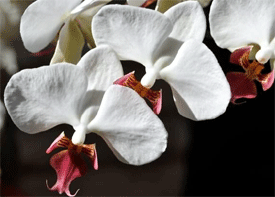
Orchids and many other flowers are often given common names that reflect their shape, color, scent, habitat or behavior. While the Latin names that scientists and botanists use provide a more precise identification of an orchid, indicating the plant’s genus and species, common names are must easier for the casual gardener to remember -- and pronounce. It probably didn’t take long for orchid admirers to replace tongue-twisting Phalaenopsis with Moth Orchid.
Exceedingly popular for its large, colorful and long-lasting flowers, the Phalaenopsis orchid resembles a beautiful moth with its wings spread open. In fact, in modern Greek, which has its roots in Latin, Phalaenopsis means moth-appearing (phalaina means moth and opsis means appearance). Available in every color of the rainbow except blue, Phalaenopsis orchids may also exhibit interesting and unusual color markings. The harlequin Phalaenopsis, for example, is bright pink distinguished by an unusual marbled pattern of dark maroon blotches that decorate the outer edges of its fringed petals.
Generally, orchid color, shape and sometimes scent are dictated by the reproductive needs of the flower. The lip of Phaleanopsis orchids, for example, is shaped to serve as a resting ledge for pollinating insects. Sometimes, an orchid’s coloration mimics the favorite food of its pollinating insect. The Dracula orchid (Dracula lafluerii), a blood red species with pointed fang-like petals, relies on a particular species of fruit fly for pollination. Because these fruit flies feed on mushrooms and fungi, the Dracula orchid has adapted its appearance and scent to mimic the shape and smell of rain forest mushrooms.
The Lady Slipper orchid is another orchid species named for its unusual shape. Its unique pouch-shaped lips give this orchid the fanciful look of a medieval lady’s slipper. Cymbidium orchids are called boat orchids for the hole-like cavity created by the orchid’s lips that looks like a tiny boat floating on a floral sea.

Copyright Just Add Ice® Orchids 2023